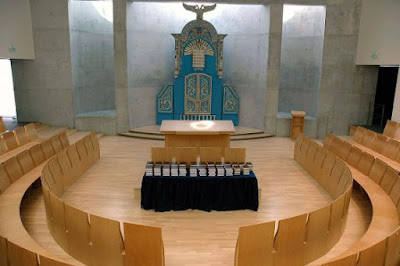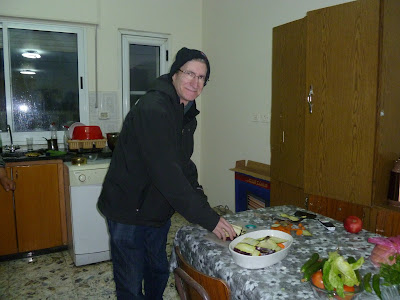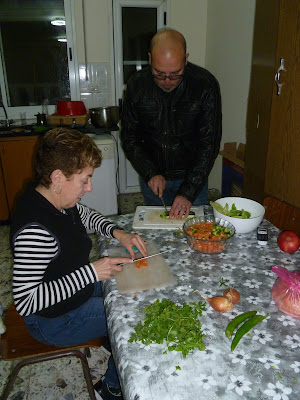Today we visited four different places in the Jerusalem area. Each, in its own way, demonstrated a marked contrast. Come with us as we describe them.
The first is Yad Vashem, the World Holocaust Remembrance Center. In Hebrew, "Yad" means "hand", and "shem" means "name". "Yad" also means "memorial". So this site serves as a memorial to the names of all 6,000,000 lost in the Holocaust.
There are a number of museums and other exhibits on the site. The first is the Holocaust History museum. The building itself has meaning. It is shaped like a triangle and is actually built through the hillside. You go in at one end (which is very dimly lit) and view the exhibits, and eventually get to the other end which is a full floor-to-ceiling pane of glass letting in all the light, and the view overlooks Mt. Herzl, Jerusalem, and Israel in general. You have made it to the Land of Zion. Quite powerful.
In the museum itself, one is forced to snake through, seeing one exhibit room on the left, going back across the center aisle where that light is still oh so far away, and then seeing the exhibit room on the right. Back and forth...following others...no choice. The exhibits try to contrast the nationalistic fervor and anti-Semitism of 1930s Germany (and beyond) with stories of individuals -- via video interviews, artifacts and photographs, and many quotes and other written descriptions of a world gone mad. We think one quote (paraphrased) on the wall at the end summarizes this:
"The Holocaust was not the killing of 6,000,000. It was six million murders, one person at a time."
Leaving the museum, we walked down the Avenue of Remembrance. Here, down the side of the hill, are planted hundreds of trees -- each one with a small placard bearing the name(s) and country of the Righteous -- non-Jews who risked their own safety and lives to help Jews survive.
Then we came to the Valley of the Communities. This is a maze-like area filled with giant rough-cut stones (almost like those in the Temple Mount) in pillars that each tower about 25 feet up.
Each "room" in the maze has the name of a country inscribed on one of the pillars, and then on the ones near it, the names of the cities in that country where Holocaust victims came from are inscribed from top to bottom. For some, like Poland, there were at least 6 of these pillars. On one of these we found the names Tyczin (Tikocin) and Jaroslaw, from which Wayne and Wendy's (respectively) ancestors had emigrated in the late 19th century. There may have been family members remaining in those cities (particularly in Jaroslaw) into the 20th century. We are not certain. If they were there, the likelihood they perished in the Holocaust is high.
Walking through this maze brought to mind a metaphor. The setting of the Valley of the Communities reminded us of Roman ruins we have seen over the years. Those ruins symbolized a bygone civilization. These pillars, metaphorically--and realistically--also symbolized the loss of a civilization--the Jews of Europe. Chilling.
Nearby is the Synagogue. It showcases Judaica (salvaged after the War) from destroyed synagogues in Europe.
(Picture from the internet as photography is not allowed)
Among these are four Arks, all of which come from Romania, once home to a thriving Jewish community. One of these Arks was found
in a local Romanian’s home; he was using it as a clothes closet.
Next we walked along a flower lined path and came to this poignant display:
A cattle car, like the one that took so many thousands on a one way trip to oblivion.
Finally, the Children's Memorial. Very hard to describe this adequately, but we'll try. You walk from the bright sunlight into a small dark room. Before you are about a dozen pictures of happy, smiling children. No wall sign text needs tell you what their fate was. Then you move down a short, pitch-black hallway, with dirge-like music playing, and into a pathway that has mirrors on both sides reflecting a seemingly endless number of candles. Again, the pathway snakes so you are forced to keep turning and looking at these lights in the darkness on both sides of you. Each light is a child whose life was needlessly snuffed out.
All of this is on a lovely, peaceful, wooded mountaintop, just a few miles from the bustling downtown.
So there are contrasts of
darkness : light
death : life
war : peace
despair : hope
filth and disease and destruction : beauty
screams and wailing and the sound of gunfire : silence
horrors beyond imagination : normalcy
One last note on Yad Vashem and travel in general. Our travel experiences can be somewhat likened to viewing drama, art, or literature: we interpret them through the lens of what is going on in the world (and in our own lives) as we experience them. When we think of the photos from Aleppo over the last two weeks and just this week's US electoral college results, it is clear that we had no choice but to view today's visit of Yad Vashem differently from 2014 when Wendy first visited. If possible, our reactions to the stirring displays of refugees being turned away and the frightening images of the rise of the Third Reich were even more visceral than before. So we must remind ourselves: Never again.
Our next stop was the nearby suburb of Ein Karem (meaning "Spring of the Vineyard"). The town is mentioned in the Bible, and is considered the birthplace of John the Baptist. It is a truly lovely spot; if you dropped someone in here blindfolded and then opened their eyes, they would guess they were in a small Italian or French town...it has that Mediterranean look, including a number of churches; so different from the boxy limestone buildings that make up much of Jerusalem's architecture.
The contrast here? Now almost 100% populated with Jews, this was a Palestinian town before the residents were depopulated in the 1948 Arab-Israeli War. The land and buildings were all confiscated and new residents moved in.
After experiencing all the despair of Yad Vashem, and hearing the story of Ein Karem, Yuval decided we needed a time out. This was delivered via two magnificent stained glass works of art. The first was at the Hadassah Hospital, situated above the town (but still part of it) at the top of another hill. In the hospital's synagogue are 12 beautiful stained glass windows by Marc Chagall. Each window represents one of the twelve tribes of Israel.
The second was a mile or so away at Israel's National Public library (at the Hebrew University in West Jerusalem). This huge triptych , by Mordecai Ardon, is dedicated to Isaiah’s vision of eternal peace.
No contrasts here...only light and beauty.
Back on the tour:
Our next stop was Mea Shearim--an ultra orthodox (Haredim)
community at the easternmost tip of West Jerusalem. This insular Eastern
European community has almost been frozen in time since its inception in the
late 19th century-- very conservative dress, no TV, no SmartPhones, certainly no internet, minimal
restaurants or cafes, and Yiddish (not Hebrew!) spoken everywhere you turn. The poverty level is rather high here. This is not a destination for tour groups,
so being observers was fascinating.
The contrasts here:
Time: Using the "blindfolded visitor" analogy again, someone dropped in here could easily believe that a time machine had taken them back to the turn of the century.....the 20th!
Space: Jerusalem is "divided" (populated) in three main areas: East is inhabited by Palestinians (actually Palestinian Citizens of Israel); West Jerusalem is the Jewish Israelis; and this small enclave (really a self-imposed Ghetto) on the edge of West Jerusalem. Residents of each rarely go into either of the other. They live in their own separate worlds...so close, yet so far apart.
We concluded our day with an ultimate contrast to how we began--
traveling over the Green Line to Bethlehem on the West Bank and the home of our
dear friend, Husam Jubran, from Hands of Peace (and who was also Yuval's partner guide for Wendy and Emily's 2014 trip).
We met up with Husam at a promontory overlooking one of the contentious West Bank settlements.
Before crossing the Green Line he informed us that, if asked at the checkpoint, we should characterize Muhammad as our friend-- not our driver. There wasn't any issue at the checkpoint coming or going but we could tell that Muhammad was anxious and so were we.
Before crossing the Green Line he informed us that, if asked at the checkpoint, we should characterize Muhammad as our friend-- not our driver. There wasn't any issue at the checkpoint coming or going but we could tell that Muhammad was anxious and so were we.
We had asked our tour company for a cooking
class and had even priced some in Jerusalem. Frankly, we already
consider ourselves good Jewish cooks (though not necessarily skilled in
Israeli techniques). So, when Husam said that his mom would teach us to cook
Palestinian style, we simply couldn't resist. However, this "class" was more like a "let's help Husam's mom cook a dinner for the family" than anything else
and, as such, it was unlike any other cooking class we'd ever experienced. It
was a total blast!
During dinner prep, we met Husam's twin boys, two nephews and the rest of the extended family. The Mideast TV station (Egyptian and Saudi secular shows) was in the background, and there was a constant din.
During dinner prep, we met Husam's twin boys, two nephews and the rest of the extended family. The Mideast TV station (Egyptian and Saudi secular shows) was in the background, and there was a constant din.
We helped prepare enough for 9 (including a large serving of ka'ak -- Jerusalem ring bread)...
...though most of the food was gobbled up by Husam's extended family.
Contrasts? Ha Ha! As we had never cooked in someone else's home kitchen before-- let alone another culture where English was spoken quite well by Husam but not necessarily by his mom--that was an experience in itself and raised lots of questions (most of which we dared not ask): Is the water safe to drink/ cook with? Are there paper towels? Where are the napkins? Is this how you set the table? We don't season the chicken? We're mixing this with our hands? Isn't there a recipe? Shouldn't we be measuring these spices? Don't we need to set the timer? Are we really cutting this on the counter?
Family cooking at its finest! When all was said and done, the results were worth any questions we had. Delicious!!!!! To the "is the water safe to drink?" query, Husam said without prompting (but probably reading our body language), "our water is safe to drink; I can't speak for the water in the States."
We finished off the meal with anise tea and then turned down an
invite to smoke the hookah at The Tent (a local wonderful restaurant) because
we were wiped out (and Wendy had done this previously). Vacation is exhausting! As an aside, Husam is expecting us to prepare Maqluba at our second annual dinner for the Hands of Peace staff this coming summer. Oy!




























No comments:
Post a Comment